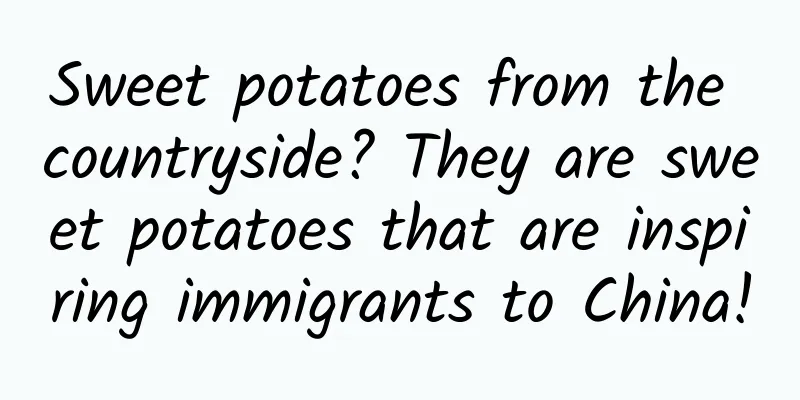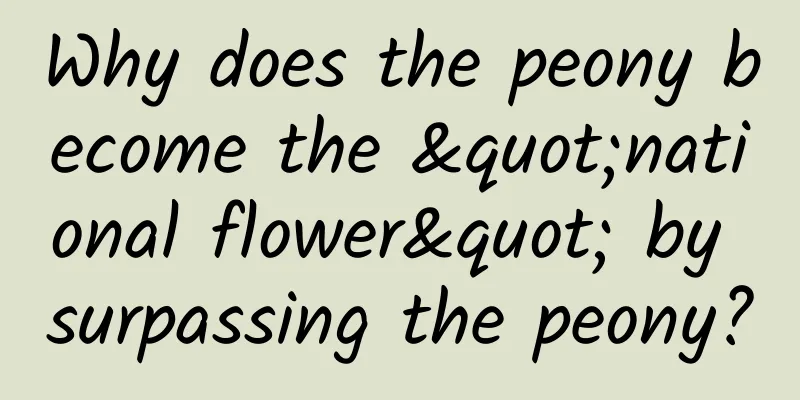Sweet potatoes from the countryside? They are sweet potatoes that are inspiring immigrants to China!

|
Sweet potatoes from the countryside? They are sweet potatoes that are inspiring immigrants to China! Lv Weitao, Curator at the National Museum of China Zhang JinMember of the Intangible Cultural Heritage Working Committee of China Arts and Crafts Association If sweet potatoes don't migrate, no one can sell them "If you are an official and don't serve the people, you might as well go home and sell sweet potatoes!" This once popular line comes from the Henan opera "The Seventh Rank Magistrate", which tells the story of a seventh-rank county magistrate who is not afraid of the powerful, enforces the law impartially, and serves the people. Sweet potato, also known as sweet potato, sweet potato, white potato, sweet potato, red potato, etc. in different regions of China, belongs to the Convolvulaceae family and is an annual or perennial herbaceous tuberous plant. The tubers of sweet potato can be eaten cooked or raw, and can also be used as feed, sugar and alcohol production. Its stems and leaves can also be used as vegetables and feed. It is a relatively important food and multi-purpose crop. However, the play "Seventh Rank Magistrate" is set during the Jiajing period of the Ming Dynasty, at least several decades before the introduction of sweet potatoes into China. Even if the county magistrate resigned and returned home, he would not be able to sell sweet potatoes. You know, if it weren't for Fujianese Chen Zhenlong (about 1543-1619), it is likely that no one would be able to sell sweet potatoes. Chen Zhenlong was born in Changle County, Fujian Province. He passed the imperial examination when he was young. However, with the rapid increase in population and the difficulty of the imperial examination in the late Ming Dynasty, after failing the examination, Chen Zhenlong followed the strong business atmosphere in the southeastern provinces and went to Nanyang (Southeast Asia) to do business, "traveling between Fujian Province and Luzon (Philippines)." After arriving in the Philippines, Chen Zhenlong, who had been eating rice for most of his life, ate sweet potatoes for the first time. This sweet and filling magical species immediately attracted his attention. Chen Zhenlong thought about bringing this "species" back to China when he thought about the food shortage in his hometown, the frequent droughts and floods that affected the harvest, and the difficult life of many elders due to the food shortage. During the Ming Dynasty, wheat and rice were the main crops grown in China. Just like today, wheat was grown in the north, with a yield of about 200-300 kilograms per mu, one season a year; rice was grown in the south, with two seasons a year, with a yield of about 500-600 kilograms per mu. Faced with the rapid population growth in the late Ming Dynasty, such yields could hardly sustain people's lives. The peak yield of sweet potatoes in the Philippines can reach 4,000 kilograms per mu, and the lowest yield is 2,000 kilograms. They are highly adaptable to the growing environment and can even grow well in sandy soil. The mystery of the identity of the foreigner "Sweet Potato" The Philippines is not the origin of sweet potatoes. Sweet potatoes originated in Central and South America and were cultivated as crops by Indians at least 5,000 years ago. Sweet potatoes were "discovered" many times by European explorers, adventurers, and colonial conquerors - by Columbus in the West Indies, by Balboa in Central America, and by Pizarro in Peru, etc. In Central and South America, the Indians called sweet potatoes "Camote", while the Incas called them "Batata". In 1526, the Spanish introduced sweet potatoes from the West Indies to Spain, and then from Spain to Italy, and from Italy to Austria, Germany, Belgium, and then to Britain. The spread of sweet potatoes in Europe was relatively slow. For a period of time, it was misunderstood like potatoes and was believed to contain aphrodisiacs. In order to find new drugs, the first people who were interested in these new crops were local pharmacists and botanists. Although sweet potatoes have a large planting area in Spain, they are still not as popular as potatoes throughout Europe due to eating habits and geographical conditions. Around the first half of the 16th century, the Spanish and Portuguese brought sweet potatoes to their colonies in Asia, and then from these colonies to various countries on the Asian continent. The sweet potatoes in the Philippines were introduced by the Spanish. Traveling across thousands of mountains and rivers without complaint, crossing the ocean to China Chen Zhenlong wanted to bring this species, which was both high in yield and delicious, back to China, but ideas are only ideas and it was difficult to implement them. The Spaniards at that time were also very shrewd, "valuing their species and not giving them to the Chinese", and they strengthened the inspections at the customs. It is said that the first time Chen Zhenlong hid the sweet potatoes in the bottom of a rattan box, it was found out when passing through customs, confiscated and criticized. The second time, he wove the sweet potato vines into a rattan basket and tried to carry the basket through customs, but it was found out again. He was called a thief, beaten up, and almost thrown into prison. Chen Zhenlong's two smuggling attempts failed, and he was later listed as a "strict investigation target" by the Spanish. When Chen Zhenlong was nearly 50 years old, his desire to save the people from dire straits became stronger. After pondering for many days, he finally came up with a good idea. In 1593, after bribing the local natives and getting the sweet potato vines, Chen Zhenlong twisted the vines into the water-drawing rope and smeared mud on the outside. After passing the checkpoints, he finally brought the sweet potato vines back to Fuzhou from the Philippines after a bumpy voyage of seven days and nights. That year was the 21st year of the Wanli reign of the Ming Dynasty. That year, the Ming army led by the great general Li Rusong made headlines for helping the Koreans defeat the Japanese in Pyongyang, Korea, so Chen Zhenlong's feat was submerged in the tide of the times. Trying to grow sweet potatoes is a righteous act, a blessing from both man and nature After returning home, Chen Zhenlong and his son immediately submitted a letter to Jin Xuezeng, the then governor of Fujian, suggesting that they try to cultivate this sweet potato in Fuzhou. At the same time, Chen Zhenlong took the lead in planting this kind of thing in his own farmland. Four months later, they were successful. "The small ones are as big as arms, the big ones are as big as fists, and they taste like pear dates." Fujian Governor Jin Xuezeng was very excited when he learned about it. He immediately praised Chen and his son for their "righteous deeds" and "although it is human work, it is actually God's grace." He then began to promote the introduction of sweet potatoes throughout Fujian Province. This is undoubtedly the best gift from God to Chinese farmers who have been struggling to make ends meet for a long time. The food revolution and population revolution triggered by Chen Zhenlong's smuggling of sweet potatoes in China cannot be overstated. You should know that at the end of the Ming Dynasty when Chen Zhenlong lived, China's actual population had exceeded 100 million. Take Hui'an County in Fujian Province as an example. Due to the rapid population growth and insufficient land, in the fifth year of Longqing (1561), this small county with a population of just over 10,000 households had to import about 70,000 dan of rice (about 13 million catties today) every year to feed the entire county population. If sweet potatoes had not been introduced, many Chinese people would have starved to death under the circumstances at that time. It can be seen that Chen Zhenlong's contribution is indispensable. During the Daoguang period of the Qing Dynasty, Fujian people built the "Xianshu Temple" and "Xianshu Pavilion" on Wushi Mountain to commemorate Chen Zhenlong, who had made great contributions to the introduction of sweet potatoes. Of course, the introduction of sweet potatoes to China was not the work of Chen Zhenlong alone. It is now certain that Spanish sailors brought sweet potatoes to Luzon, and Portuguese sailors brought sweet potatoes to Jiaozhi (now Vietnam). After the sweet potatoes were introduced to Asia and then to China, they were introduced through multiple routes. It was introduced into China around the end of the 16th century. There are at least three possible routes, including the one led by Chen Zhenlong: first, the Portuguese spread it from America to Myanmar, and then to Yunnan, China; second, the Portuguese spread it from America to Vietnam, and then Chen Yi from Dongguan, Guangdong, or Lin Huailan from Wuchuan, introduced it to Guangdong, China; third, the Spanish spread it from America to the Philippines, and then Chen Zhenlong from Changle, Fuzhou, introduced it to Fujian, China. According to research, the introduction of Chinese culture from Yunnan, Guangdong and Fujian took place almost simultaneously. However, the introduction from Chen Zhenlong was more clearly and fully documented in historical records, and has been repeatedly verified and commented on by later researchers, making it more well-known and influential. Immigrants to China, do as the Romans do Sweet potatoes are resistant to waterlogging, drought and barrenness, and are particularly suitable for China's terrain, soil, climate and Chinese tastes. He Qiaoyuan wrote in the Minshu (Book of Fujian) around 1600 that due to the widespread cultivation of sweet potatoes, in Quanzhou, "a pound is not worth a penny, and two pounds can fill you up", so people from the elderly to children and street beggars can eat them. Xu Guangqi summarized 13 advantages of sweet potatoes, including high yield and benefits for people, white color and sweet taste, rapid reproduction, disaster prevention and hunger relief, can be used as a basket (sacrifice), can be used to make wine, can be stored for a long time, can be used as cake bait, can be eaten raw or cooked, does not affect agricultural work, and can avoid locusts. Due to these advantages, sweet potatoes were introduced to most parts of the country during the reign of Emperor Qianlong of the Qing Dynasty. There is even a folk legend that sweet potatoes once became a special ingredient in Emperor Qianlong's "imperial cuisine" and cured his chronic constipation in his later years, which led to a sharp increase in their value. In addition, after the sweet potato became popular in China, the working people gradually developed cultivation techniques such as "deep ploughing and thick burial" through exploration. As stated in the Ming Dynasty's "Qunfangpu", "deep ploughing should be done before the New Year, and the soil should be covered with manure, and the seeds should be planted after the spring equinox." When planting sweet potatoes, ridges should be made to facilitate drainage and ventilation, and the soil layer can be deepened to facilitate sweet potato production and labor. The book points out that "seed potatoes are best planted on high ground and sandy land, with ridges of more than one foot and planted on the ridges. In case of drought, wells can be used for irrigation." The introduction of sweet potatoes improved the planting structure of Chinese crops and the diet of Chinese people. Sweet potatoes became one of the important foods for China to overcome famine and hunger in the past. It is often recorded in the history books of Ming and Qing dynasties that "seven out of ten villagers survived on potatoes" during famine years. China's population development also ushered in a historical blowout. In the 39th year of Emperor Kangxi (1700), China's population was about 150 million. Less than a hundred years later, in the 59th year of Emperor Qianlong (1794), the population of the Qing Dynasty soared to 313 million. Sweet Potato China - A China of Openness and Communication Today, China has become the number one producer and consumer of sweet potatoes. Sweet potatoes rank fourth among China's food crops, with the planting area remaining at 75-80 million mu all year round, accounting for about 60% of the world's planting area, and the annual output is about 120 million tons, accounting for about 80% of the world's total output. In China, not only have we developed ways to eat sweet potatoes, such as roasting sweet potatoes, cooking sweet potato porridge, and steaming sweet potato with rice flour, but we have also created dried sweet potatoes that are like snacks or candies, such as drying and frying. In addition, we have also created proverbs and allusions such as "If an official does not serve the people, he might as well go home and sell sweet potatoes." Sweet potatoes, which have come from afar, have played and will continue to play an important role in the economic and social life of the Chinese people. It's not just sweet potatoes. If we take stock of the modern Chinese table, many of the ingredients we take for granted are actually imported. They were introduced so long ago and planted so widely that we have forgotten their imported status. These ingredients include potatoes, tomatoes, peppers, peanuts, walnuts, sesame seeds, peppers, spinach, watermelons, carrots, corn, cucumbers, garlic, and so on. Zhang Qian's voyages to the Western Regions and Zheng He's voyages to the West both introduced a wealth of overseas ingredients. To this day, if we want to enrich our food baskets and tables, we still cannot do without imported ingredients. Our stomachs tell us that trade, openness, and exchanges will never go out of style. |
<<: What's so special about the robots that scientists were inspired to create by this fish?
>>: The dwarf killer: the African pygmy falcon
Recommend
European Automobile Manufacturers Association: European new car sales in November 2024 will be 1.06 million, a year-on-year decrease of 2%.
European car sales fell last month as slowing dem...
Zhao Xiaoming's Basics: New Psychoanalysis - 100 Core Concepts Audio Course Baidu Cloud Download
Zhao Xiaoming's Basics: New Psychoanalysis - ...
BMW builds factory in Indonesia to boost luxury car sales
BMW launched the 7 Series sedan in Indonesia on N...
How to teach your girlfriend programming?
[[146883]] Ever since I started as a software dev...
How much does it cost to invest in Yan'an Electric's mini program?
How much does it cost to attract investment throu...
Learn the correct method to improve exposure!
My friends, I believe many of you are worried abo...
How to design a user activation growth strategy from 0 to 1
User activation is the first step after completin...
What is invisible secondary pollution?
How do you define whether your home is clean if y...
There are more than 700 million mobile phone users using WeChat, so why don’t we develop mini programs and public accounts?
WeChat users exceed 700 million mobile phone user...
How can you pay by just tapping?
Have you used the new “touch and pay” feature of ...
Price positioning advantage no longer exists, mid-range joint venture car companies are under attack from all sides
There is a Hualian shopping center located on the...
Is it really that easy to follow hot topics? Understand the correct way to follow hot topics in one article!
How to follow hot topics, what is the significanc...
Why is mobile banking important to the banking industry?
With the popularity of mobile banking, people hav...
Adapting ATS from server to iOS client
iOS 9 has been released, and everyone has to expe...
156 sets of high quality cosmetics wedding dresses chemical dreamweaver source code free download
156 sets of high quality cosmetics wedding dresse...









